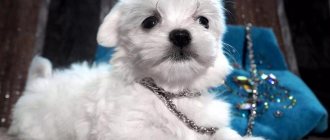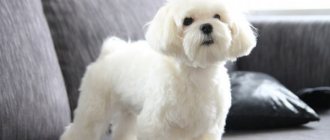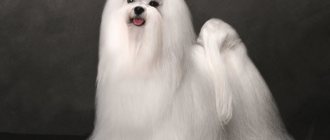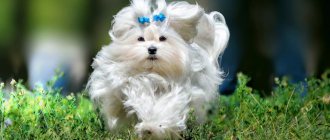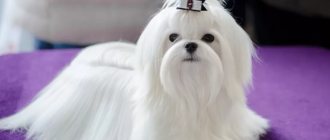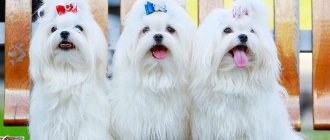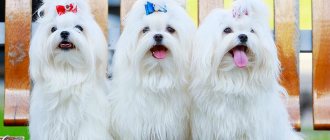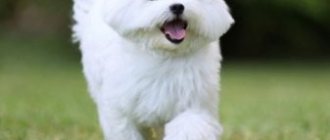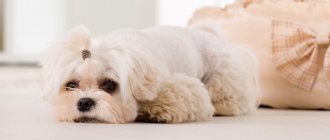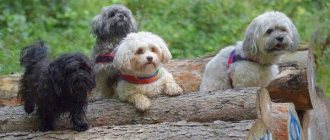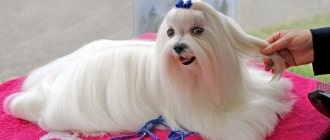Today, decorative dogs are gaining great popularity among animal lovers. One of the most popular is the Maltese, which is considered one of the oldest breeds. She was created for communication: this snow-white dog is sociable and energetic. Maltese will fit well into any family and will easily acquire the status of everyone's favorite.
Origin story
The first mentions of the breed are found in the writings of Ancient Egypt, where there were images of animals. Back then, unusual small dogs were considered an expensive gift given to noble people. The presence of a Maltese dog in the family spoke of the wealth of the owners and their luxurious lifestyle.
The history of breeding modern representatives of the breed begins in Great Britain, where they came from the Philippines. The First World War threatened many breeds, including the Maltese, with extinction. Breeders had to make a lot of efforts to preserve this breed. Already in the 30s, a breed club was formed, and the Maltese population was gradually restored. At the same time, dogs are actively spreading throughout the United States. Today, mono-exhibitions are held there annually.
Interesting Facts
Over the centuries-old history of Maltese dogs, a lot of interesting things have happened to them:
- According to one version, the name of the breed comes not from the name of the Mediterranean island, but from the Latin word malat - “harbour”. This assumption arose due to the fact that Maltese originally traveled with sailors and were a threat to ship rats.
- There is a possibility that Maltese dogs took part in the formation of the Pekingese.
- Dogs of this breed have been the muses of many famous artists. Images of the Maltese are found in paintings by Rubens and Goya.
- Maltese dogs were the favorites of many crowned heads. Tiny snow-white dogs lived at the court of the French king Louis IX, the Spanish ruler Philip II, the English Queen Elizabeth I and Empress Catherine II.
Description of the breed
The Maltese dog has a proportionally developed body, and its movements are smooth. The weight of an adult dog is no more than 4 kg. Boys are several centimeters taller than girls. The size of an adult dog is 20-25 cm, which makes the animal very compact.
Description of the breed:
- The skull is flat, larger in size than the muzzle. The forehead is clearly defined. The ears are triangular in shape, set high, and fit tightly to the head.
- The nose is small, the earlobe is black and large. The jaws are developed and small. They do not protrude beyond the muzzle, the lips are thin, and the bite is scissor-shaped.
- The eyes are round, the color of the iris is dark brown. The breed standard does not include deep-set or protruding eyes.
- The neck stands out, is covered with thick hair, there are no folds. The back is straight, the chest is deep.
- The tail is set high. It is thicker at the base and thins towards the end. The shape is arched, slight deviation to the side is acceptable.
- The front legs are located close to the body. The limbs are not muscular, but the bones are strong. The fingers are pressed tightly together, the pads are painted black.
Dogs' fur is long and dense, soft to the touch. There are no curls or curls. The limbs may be slightly shaggy. The standard color of the Maltese is white, but pale orange or ivory is acceptable. But such tones can give the coat a gray, dirty look and are therefore considered undesirable.
There is an American subtype of the breed, which is considered its mini version (weight from 2.7 kg, does not exceed 3.2 kg). The coat of such animals is somewhat shorter, but it cannot be said that this dwarf dog is short-haired.
Character
The external characteristics of the Maltese completely coincide with its character. A dog that appears funny and cute is friendly, active, and affectionate. The pet is devoted to all family members; its docile nature makes the Maltese accessible to an inexperienced dog breeder.
Even despite its fragile appearance, the Maltese will always rush to protect its owners in moments of danger. Moreover, it doesn’t matter to her who the potential threat is: an animal or a person. The dog usually warns of its intentions by barking loudly, but may also use its teeth. This behavior proves that even small pets can be brave when it comes to keeping their owners safe.
Maltese has an extraordinary intelligence, thanks to which he can easily master not only basic commands, but also complex tricks. However, some of them can be quite stubborn due to the fact that their owners spoil them too much.
It is better not to have miniature dogs in families with small children, as they can accidentally injure the animal during play. But lap dogs will get along well with an older child.
The Maltese has a friendly disposition towards other animals. It will not harm cats or rodents. The animal is very attached to its owners, so it is not worth leaving it for a long time. Otherwise, the dog will begin to worry, which will lead to severe stress.
Appearance
There are 2 Maltese breed standards - American and European and, accordingly, two types of dogs, differing primarily in proportions.- Europeans have clearly defined ratios: the length of the head (from the back of the head to the nose) corresponds to 6/11 of the height at the withers. You can calculate, for example, the head length of a Maltese 24 cm tall: 24/11*6=13.09 cm
- As for the front part of the skull, the length of the muzzle is related to the length of the head as 4 to 11. Accordingly, in our example, the length of the muzzle will be 13.09/11*4 = 4.76 cm
- Americans do not have specific numbers in the standard, but the head should be more rounded, the length of the muzzle shorter and the body not so stretched.
Nowadays the “Korean” type of Maltese is very popular - large eyes, short baby-face muzzle, size slightly smaller than the standard. In Korea, cynologists have only recently begun to work with this breed, and mostly breeders for nurseries were brought from America.
Let's consider the FCI standard, which is used in Russia.
- The size should be between 3 and 4 kg. However, the current fashionable trend towards reducing the size of decorative dogs has led to the fact that the average weight of a lapdog is about 2.5 kg.
- The length of the back is one third greater than the height at the withers. The straight line of the back should be maintained both at rest and in free movement.
- The coat is straight, silky and without undercoat. Optically white in color, falling in long, heavy strands along the dog’s body.
Care and maintenance
It is possible for a Maltese to live in both a large house and a small apartment, but the first option is still preferable. This way the pet can have constant contact with its owners. The peculiarity of the Maltese, like other small dogs, is that the animal can be trained to go to the litter box.
To maintain the elegant appearance of a lap dog, owners will have to put a lot of effort at home. Moreover, this requires not only time, but also material costs. Animal care comes down to the following points:
- Combing. The dog practically does not shed, but the coat needs daily combing to maintain a neat appearance.
- Bathing. The animal should be bathed using special shampoos and balms designed for long-haired dogs. Sometimes you can use care products to prevent the formation of tangles.
- A haircut. If the owners do not plan to participate in exhibitions with the dog, they can do a daily haircut. A shorn dog wears short hair, with the length kept to a minimum. Also popular are hygienic haircuts, in which most of the hair is shortened on the genitals. Grooming a dog once for a show is not enough. This procedure must be repeated at least 3 times a year.
There is a summer version of a puppy haircut that improves heat exchange in the summer. This grooming allows owners to spend less time caring for the coat.
Particular attention should be paid to the eyes, where dirt regularly accumulates due to tearing. In this case, the eyes become red and dark tracks appear under them. This can happen for various reasons:
- influence of external factors (dust, wind, etc.);
- internal processes in the body (estrus, change of teeth, postpartum period);
- allergy;
- inflammation associated with disease (for example, conjunctivitis).
If your eyes are running, you must first determine the cause that caused this condition. Typically, most are temporary or can be resolved with medication.
Feeding
When feeding your lapdog, it is important to consider the following points:
- Do not overfeed. Representatives of the breed are prone to obesity, so overeating threatens gastrointestinal, heart and digestive diseases. You can understand that an animal is overeating not only by rapidly gaining weight. At first, the dog’s stomach is churning, as the gastrointestinal tract cannot cope with the volume of food received.
- Do not feed human food. Many foods from the household table, for example, sausages, canned food, sweets, can lead to digestive disorders. Also, such snacks can throw off your eating schedule.
If the owners are going to feed the animal with dry food, the brand should be at least premium. Moreover, the food is intended for miniature dogs.
If the food is natural, then the pet’s menu should include:
- lean meat (boiled beef or chicken);
- kefir;
- cottage cheese;
- porridge (buckwheat or rice);
- apples;
- eggs.
If the food is not suitable for the pet, this can be determined by the condition of the coat. When the coat becomes dull, brittle, or dandruff forms, these are signs of improper feeding.
What to feed a puppy
Puppies can also be kept on natural food or commercial food. There are usually no problems with the latter. Babies can be given dry food starting from 1 month. It can be slightly soaked in water beforehand for better chewing.
When feeding naturally, the puppy's menu should contain:
- porridge with added meat;
- pure meat (beef, rabbit or turkey);
- sea fish without bones;
- vegetables and herbs;
- cottage cheese.
At the age of 2-4 months, babies should eat 4 times a day, at 4-6 months - three times a day. From 8 months, the puppy gradually becomes an adult dog, so feeding should be done twice a day.
Nutrition
In order for the Maltese dog to develop properly, to be full of strength and energy, and to maintain health for many years, it is best to give it special dry food. Its manufacturers guarantee the balance of all components and compliance with all the necessary proportions of microelements and vitamins in it.
It is advisable to consult a veterinarian and check reviews about the manufacturer before choosing food. In addition, it must be selected according to age and individual characteristics.
But there are dog owners who do not trust dry food and prefer to prepare food for their pets themselves. In this case, the main thing is not to forget to add the necessary minerals and vitamin complex to the dog’s diet. This will help keep your dog in great shape.
Maltese dogs can be given poultry, beef, chicken eggs and various vegetables. Mixes and mixtures can be made from these ingredients. In addition, fish is sometimes introduced into the diet, which must be pre-cooked. Various cereals are also served with fish. For example, buckwheat or rice.
In addition to what to give your dog, you also need to know how to do it correctly. It is not recommended to keep a bowl of food on the floor all the time, that is, put a portion on the floor. After eating, he cleans up and washes himself. Next time everything is repeated again.
In addition, it is better not to leave food in the dog’s plate in reserve. Meals should be on a schedule. Adults need to break their food intake into 2 stages. At the same time, in the morning, porridge is given with milk, water or meat broth with the addition of pieces of chicken or beef.
Maltese puppy
In the evening - mixes of meat and vegetables, as well as eggs or fish. Portions should be small so that the dog does not gain much weight. Since this will have a bad effect on the functioning of her internal organs. In addition to standard dishes, the Maltese dog can sometimes be rewarded with treats. You can buy them in specialized stores.
Training and education
The Maltese is not at all like the large fighting dogs that have been trained since childhood. But this does not mean that there is no need to train the animal. Its socialization and training also need to be done from the first days of the pet’s stay in the house. By 2-3 months, the puppy should normally respond to its name and know several basic commands.
The establishment of prohibitions plays an important role in education. If something is prohibited for a pet, household members need to support these rules. Do not give your dog forbidden food or let him sleep on the sofa, no matter how tearfully he asks.
The basis of any training is patience and reinforcement of correct actions. If the owner speaks rudely to the pet, this can discourage any desire to learn and offend him for a long time. In order for socialization to be successful, the Maltese, while still a puppy, must be walked in special places intended for dogs. This will help the animal calmly perceive the environment.
There is a myth that small dogs should not be trained, but this opinion is not only wrong, but also dangerous. An untrained animal is at great risk on the street.
Reviews from fans
Anastasia: Devoted to her master. The animal demonstrates its love very vigorously and in some cases may even wet itself with joy. Difficulties in maintenance can be caused by constant brushing; without it, the dog’s hair quickly gathers into clumps that are difficult to comb.
Elena: Maltese is of noble origin and behaves like a king. The dog loves to lie on the bed and will not sleep on a dirty rug in the hallway. The food bowl should always be clean and the water fresh. If you don't have enough time to care for an animal, then this breed is not suitable.
Alexander: The lapdog is the best friend for children. The small white fluff ball happily plays and runs around the house. Will not bite a child in any situation. He is friends with the house cat and even sleeps with him on the owner’s bed.
Diseases and life expectancy
The formation of the oldest breeds took place without the participation of breeders, so Maltese raised in natural conditions have strong immunity.
But, nevertheless, they have a number of hereditary diseases:
- lameness resulting from a dislocated kneecap;
- problems with the gastrointestinal tract;
- blindness;
- hypoglycemia;
- allergy;
- dermatitis;
- eye diseases.
With proper care, Maltese dogs can live 12-15 years, which is considered a good age for dogs.
Advantages
The breed has many advantages. Owners, for the most part, do not even know what negative aspects lap dogs have. In fact, it all depends on upbringing. In general, the Russian Tsvetnaya lapdog breed was bred as an easygoing small decorative dog with a gentle character and lack of aggressiveness. In addition to these positive qualities, you can add the following advantages:
- Devotion, love, affection;
- Playfulness and energy (dogs remain active until old age);
- Lapdogs love children and people around them, treat other animals well, and even get along easily with cats;
- Dogs adapt to the rhythm of their owner’s life and sense his mood;
- Strong build (for a decorative dog, Colored lapdogs are very strong);
- Bravery and courage (they have protective instincts, they can bark at strangers, protecting their owner);
- High intelligence and ability to train;
- Cute original appearance, no shedding;
- Suitable for apartment living.
Flaws
Among the shortcomings of the breed, one can highlight only intolerance of loneliness. The dog begins to miss its owners and mope. Such pets are ready to literally follow the heels of their household members and accompany them on trips.
They can be quite naughty and spoiled, but this only occurs in the absence of upbringing. The dog's behavior always depends on the family.
How to choose a puppy
Choosing an animal for a person who is not an expert in the field of dog breeding is quite problematic. This is due to the fact that puppies are usually taken from their mother at 2 months, but their fur has not yet changed to an adult's, which makes it difficult to determine its structure. The coat should not be too fluffy or frizzy. A slight waviness is allowed, which usually straightens out as the dog grows.
The first vaccinations for puppies can be given as early as 1 month, so you need to find out in advance which vaccinations your pet already has and which ones are yet to be given.
The remaining requirements for choosing a puppy are similar to choosing another breed. There should be no bald patches or redness on the pet’s body, and the eyes and ears should be clean. The puppy does not show aggression or shyness and easily makes contact.
If owners need a lapdog for breeding, it is best to buy a female dog, because owners often offer males for breeding. The first mating should occur no earlier than the third estrus, then the expectant mother will be fully formed and will be able to bear offspring.
Comparison of breeds
There are several breeds that are similar to the lapdog.
Maltese or Shih Tzu
Once upon a time, both breeds could only be found in families of privileged segments of the population, so they gained a reputation as noble dogs. Both pets require careful care, paying special attention to their coat. The Maltese is smaller in size than the Shih Tzu, which weighs about 6-8 kg. The Shih Tzu also comes in a variety of colors.
In addition, animals have different personalities. If a lap dog usually singles out only one family member and assigns him the status of owner, then the Shih Tzu is equally courteous with everyone.
Maltese or Yorkshire Terrier
Caring for the Maltese is more complex, especially with regard to the coat and eyes. At the same time, their coat is softer to the touch than that of a Yorkie. Also, Yorkshire terriers are energetic and active, which means they require more time for walking and playing. The Maltese is a more affectionate and calm dog.
Maltese price
The price of a Maltese depends on many factors and varies widely.
- The most expensive dog is the Maltese dog with show prospects and an elite pedigree. The price of such a puppy can reach 80 thousand rubles.
- A purebred dog with documents but a mediocre exterior costs about 20 thousand rubles.
- Maltese mini or baby face can be bought for 35-45 thousand rubles.
Maltese dogs are adorable dogs with a luxurious white coat that contrasts sharply with their dark eyes and black nose. Good-natured mischief-makers attract admiring glances and will become wonderful companions for those who are not too lazy to care for their luxurious fur coat.
Pros and cons of the breed
| pros | Minuses |
| There is practically no shedding | No pronounced security and watchdog qualities |
| Gets along well with children and pets | Requires constant care for coat and eyes |
| Does not require much physical activity | Sometimes he may bark for no reason in the apartment. |
| Easily trainable | |
| Possibility of living in an apartment | |
| Can do agility |
Where to buy and price
The cost of a puppy primarily depends on the availability of a pedigree.
The best way to purchase a pet with famous parents is in special nurseries:
- Black Diamond (Moscow region);
- Sax-Leons (Krasnodar);
- Malyutka (Moscow);
- Vart Royal Escort (St. Petersburg).
The price of a purebred puppy with documents can cost about 20,000 rubles. The cost of exhibition animals starts at around 45,000 and can reach up to 80,000 rubles.
The Maltese can become a wonderful companion and a true member of the family. This kind, smart, affectionate dog captivates others with its appearance. If the owner is ready to maintain this beauty, not to skimp on time and love, then the Maltese will be an excellent choice.
Pet character
A lapdog often sits in the arms of its owner, usually with luxurious women. Ladies take their dogs to various events or parties. The fashion and beauty industry, hairdressers, and clothing boutiques have been created for Maltese dogs. The Maltese does not like being treated with toys due to sensitivity. The dog takes the indifference of the owner hard.
The fashion for Maltese dogs dates back to ancient times. Lap dogs remained a luxury item and were considered appropriate gifts for the ruling persons of the state. Nowadays the lapdog dog breed is much more modest, designed to amuse the owner, give joy and love, and serve as a beautiful accessory.
Maltese dogs have the following qualities:
- Weasel;
- Tenderness;
- Love;
- Cheerfulness;
- Funniness;
- Playfulness;
- Energy;
- Fearlessness.
The Maltese dog breed is incredibly fun and inquisitive. Ready to spend the day playing with children or family. They are characterized by manifestations of activity. At such moments, they are able to tirelessly run around the court without a goal, from side to side.
It is recommended to get dogs for inexperienced dog breeders who have decided to have a pet for the first time. The lapdog itself will help its owners master the basics of dog breeding and become masters. The animal achieves its goal through devotion and love for its owner.
Dogs are small in size, but can protect their beloved owner by showing strength and aggression. Little ones are not able to cope with a large fighting dog, but they are quite capable of barking desperately loudly or even biting the opponent’s legs and tail.
They perform the role of an alarm perfectly; at the slightest danger, the appearance of a stranger, they will alert the entire area with a long, piercing bark. The only negative thing about dogs is their love to bark, and from the heart.
The description of the Maltese breed continues with a mention of mental abilities. Dogs are well developed, despite the small size of the creature. Teaching your child a variety of commands and tricks will not be difficult with the right approach. A tame existence and frequent trips to salons spoil the pet’s character, as a result the dog becomes stubborn and difficult to train.
When entrusting the baby to a child, provide instructions so that the child does not injure the dog. Lapdogs have a fragile body and can be easily damaged, especially the limbs. It is better to entrust dogs to mature children who know what careful treatment and care means.
Pets get along well with other representatives of the animal world. They even feel comfortable with cats, showing no signs of mistrust or anger. For a comfortable stay for lap dogs, it is recommended to have a pair or a companion in the form of another pet. Such a solution will save the pet from emotional distress during a long absence of the owner.
